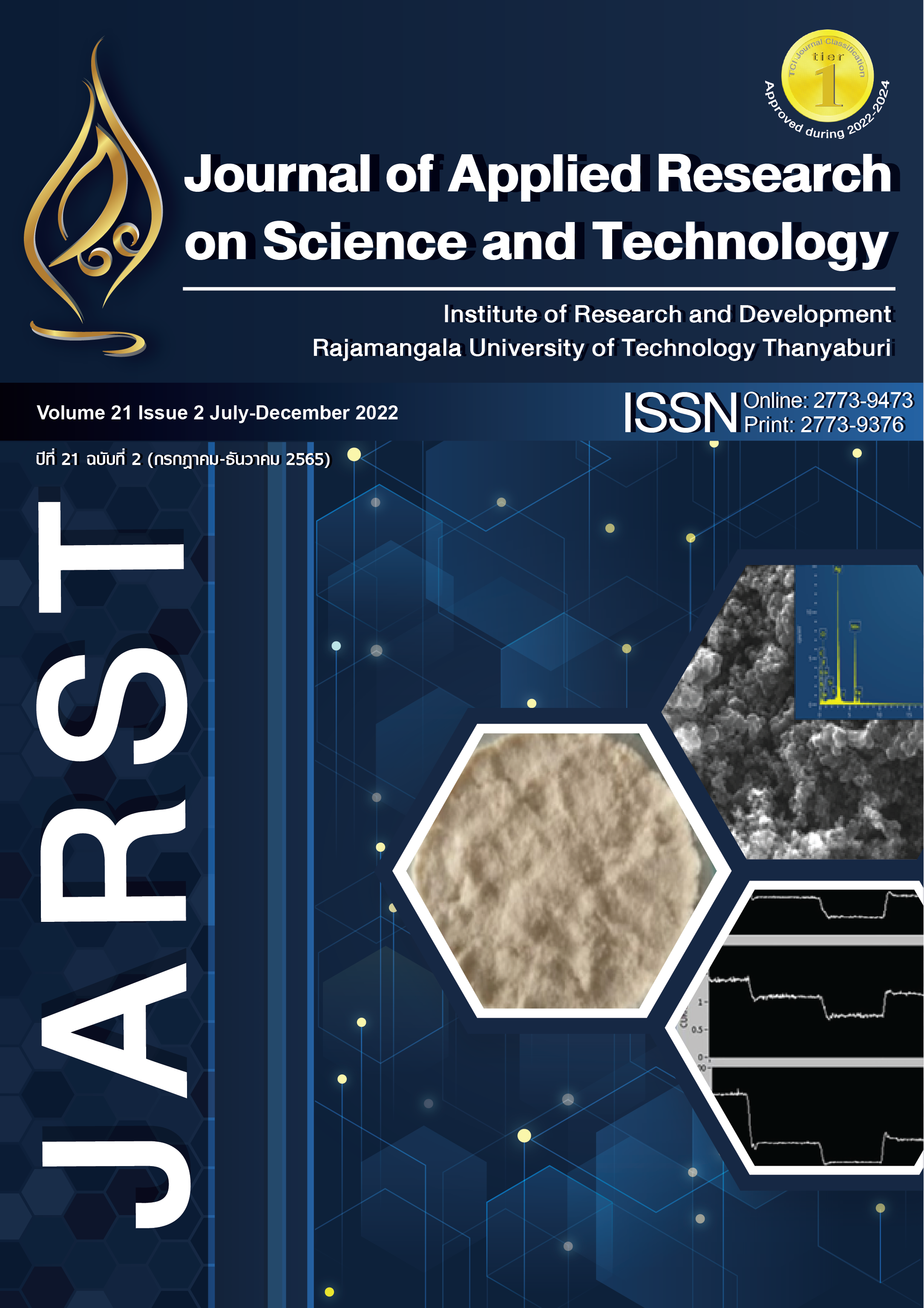Preparation of Eco-friendly Blended Bioplastic Film between Blend of Polyvinyl Alcohol and Cellulose Extracted from Nelumbo nucifera Gaertn Stalk
Main Article Content
Abstract
This research aims to prepare the eco-friendly blended biofilm between polyvinyl alcohol (PVA) and cellulose (CL) isolated from the Nelumbo nucifera Gaertn stalk using sodium hydroxide. Then, the stalk fiber was bleached treatment with hydrogen peroxide. The highest cellulose content was archived at 21.47±1.53 % w/w of dry lotus stalk. The blended biofilms at different weight ratios i.e., 90:10 (PVA-CL10) 80:20 (PVA-CL20) 70:30 (PVA-CL30) 60:40 (PVA-CL40) and 50:50 (PVA-CL50) were prepared by solution-casting method. The result of structural analysis by the FT-IR technique indicated that the CL extraction process mentioned above efficiently eliminated hemicellulose and lignin components from lotus fiber. The result of a film morphology study using a Scanning Electron Microscope (SEM) indicated that the surface characteristic of films became rougher when the amount of CL increased. The water absorption and water vapor permeability testing showed that the water absorption of PVA-CL films at all ratios decreased compared to the PVA control film. The percent water absorption of PVA-CL films increased with the enhancement of CL content, while the water vapor transmission (WVTR) rate decreased. The highest percent water absorption (97.49 ± 0.29) and WVTR (358 g/hr. m2) were achieved from PVA-CL50 and PVA-CL10 films, respectively. In addition, the result of the biodegradability analysis indicated that PVA-CL films with a high content of CL possess good biodegradability corresponding to the water absorption property of the film.
Article Details

This work is licensed under a Creative Commons Attribution-NonCommercial-NoDerivatives 4.0 International License.
References
Zhao G, Lyu X, Lee J, Cui X, Chen WN. Biodegradable and transparent cellulose film prepared eco-friendly from durian rind for packaging application. Food Packag Shelf Life. 2019;21:1-6.
Ratanasongtham P, Nikhammo A, Phlachit N. The Study of Water Absorbability and Water Permeability of Bioplastic Blend Film Between Cassava Starch Glycerol and Cellulose Extracted from Monthong Durian Bark. The 8th Academic Science and Technology Conference; 26 March 2021; Valaya Alongkorn Rajabhat University, Pathumthani; 2021. p. 529-36. Thai.
Kabir SMF, Sikdar PP, Haque B, Bhuiyan MAR, Ali A, Islam MN. Cellulose-based hydrogel materials: chemistry, properties and their prospective applications. Prog Biomater. 2018;7(3):153–74.
Klemm D, Heublein B, Fink HP, Bohn A. Cellulose: Fascinating biopolymer and sustainable raw material. Angew Chemie - Int Ed. 2005;44(22):3358-93.
Sun D, Onyianta AJ, O’Rourke D, Perrin G, Popescu CM, Saw LH. A process for deriving high quality cellulose nanofibrils from water hyacinth invasive species. Cellulose. 2020;27(7):3727-40.
Tongsawang A, Suwannawatanamatee K. [The improvement of paper properties from banana pulp with carboxymethyl cellulose]. J Appl Res Sci Tech. 2022;21(1):11-21. Thai.
Singchai B, Trakulpukdee N, Thonglim S. Essential oil from nelumbo nucifera stamen. J Sci Tech. 2017;25(1):27-34.
Chen Y, Wu Q, Huang B, Huang M, Ai X. Isolation and characteristics of cellulose and nanocellulose from lotus leaf stalk agro-wastes. Bioresources. 2015;10(1):684–96.
Tanwar R, Gupta V, Kumar P, Kumar A, Singh S, Gaikwad KK. Development and characterization of PVA-starch incorporated with coconut shell extract and sepiolite clay as an antioxidant film for active food packaging applications. Int J Biol Macromol. 2021;185:451–61.
Liu D, Sun X, Tian H, Maiti S, Ma Z. Effects of cellulose nanofibrils on the structure and properties on PVA nanocomposites. Cellulose. 2013;20(6):2981–9.
Abdulkhani A, Hojati Marvast E, Ashori A, Hamzeh Y, Karimi AN. Preparation of cellulose/polyvinyl alcohol biocomposite films using 1-n-butyl-3-methyl imidazoliumchloride. Int J Biol Macromol. 2013;62:379-86.
Xu S, Jiang M, Lu Q, Gao S, Feng J, Wang X, et al. Properties of polyvinyl alcohol films composited with hemicellulose and nanocellulose extracted from artemisia selengensis straw. Front Bioeng Biotechnol. 2020;8:1–11.
Rachtanapun P, Luangkamin S, Tanprasert K, Suriyatem R. Carboxymethyl cellulose film from durian rind. LWT - Food Sci Technol. 2012;48(1):52-8.
Chungsiriporn J, Pongyeela P, Chairerk N. [Production of molded pulp packaging from rice straw and bagasse coating by chitosan]. Burapha Sci J. 2022;27:20-30. Thai.
Karkhanis SS, Stark NM, Sabo RC, Matuana LM. Water vapor and oxygen barrier properties of extrusion-blown poly (lactic acid)/cellulose nanocrystals nanocomposite films. Compos Part A Appl Sci Manuf. 2018;114:204-11.
Kunthadong P, Peekoh M, Sindanjark O. [Bio-composite films based on cassava starch reinforced with durian rind cellulose fibers]. RMUTP Res J. 2019;13(1):39-50. Thai.
Reddy KO, Maheswari CU, Dhlamini MS, Mothudi BM, Zhang J, Zhang J, et al. Preparation and characterization of regenerated cellulose films using borassus fruit fibers and an ionic liquid. Carbohydr Polym. 2017;160:203-11.
Abderrahim B, Abderrahman E, Mohamed A, Fatima T, Abdesselam T, Krim O. Kinetic thermal degradation of cellulose, polybutylene succinate and a green composite: comparative study. World J Environ Eng. 2015;3(4):95–110.
Uma Maheswari C, Obi Reddy K, Muzenda E, Guduri BR, Varada Rajulu A. Extraction and characterization of cellulose microfibrils from agricultural residue - Cocos nucifera L. Biomass and Bioenergy. 2012;46:555-63.
Kharazmi A, Faraji N, Hussin RM, Saion E, Yunus WMM, Behzad K. Structural, optical, opto-thermal and thermal properties of ZnS-PVA nanofluids synthesized through a radiolytic approach. Beilstein J Nanotechnol. 2015;6(1):529-36.
Fatima T, Jolly R, Rafiq M, Shadab GGHA, Shakir M. Exploring the bone regeneration potential of bio-fabricated nano-titania reinforced polyvinyl alcohol/ nano-cellulose based composite film. Results Mater. 2021;12:1-12.
Cazón P, Vázquez M, Velazquez G. Composite films of regenerate cellulose with chitosan and polyvinyl alcohol: Evaluation of water adsorption, mechanical and optical properties. Inter J of Biol Macromol. 2018;117:235-46.
Laxmeshwar SS, Madhu Kumar DJ, Viveka S, Nagaraja GK. Preparation and properties of biodegradable film composites using modified cellulose fibre-reinforced with PVA. ISRN Polym Sci. 2012;12:1–8.
Gulati K, Lal S, Arora S. Synthesis and characterization of PVA/Starch/CMC composite films reinforced with walnut (Juglans regia L.) shell flour. SN Appl Sci. 2019;1(11):1-12.


